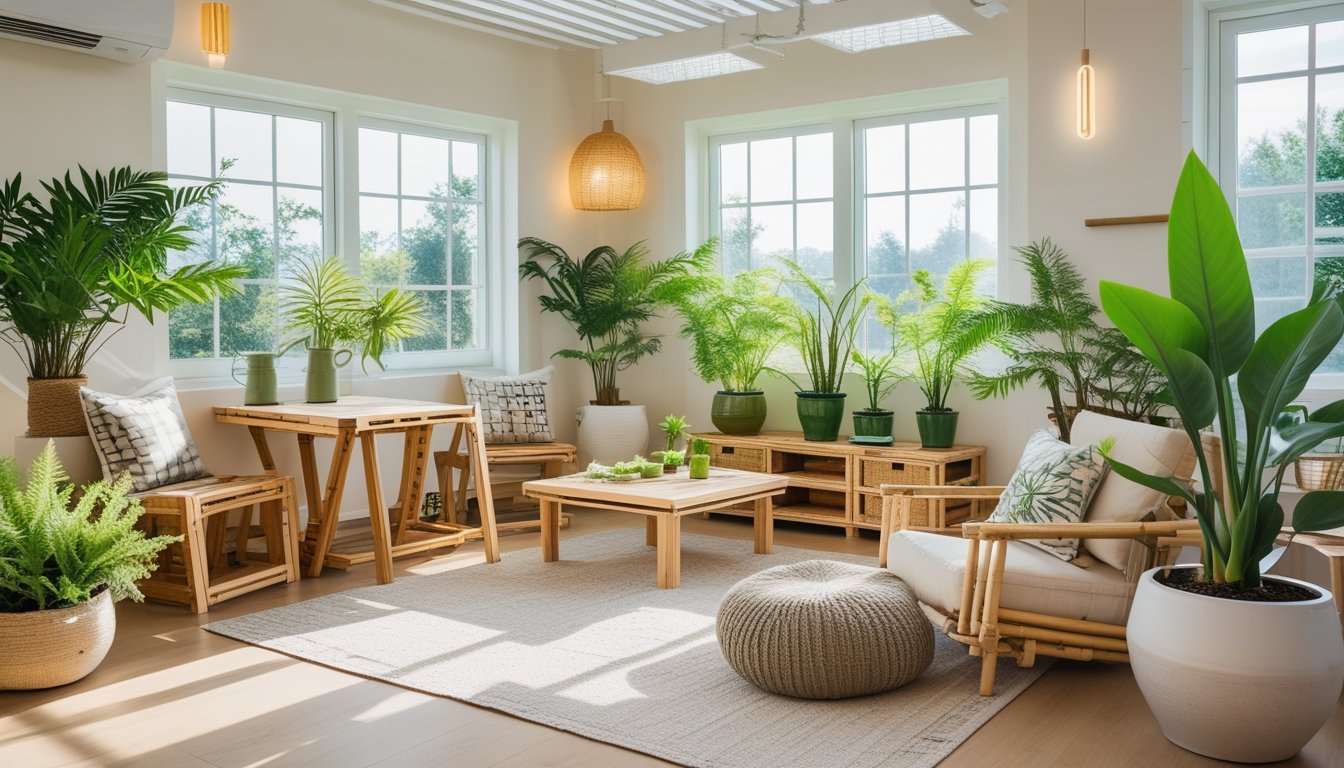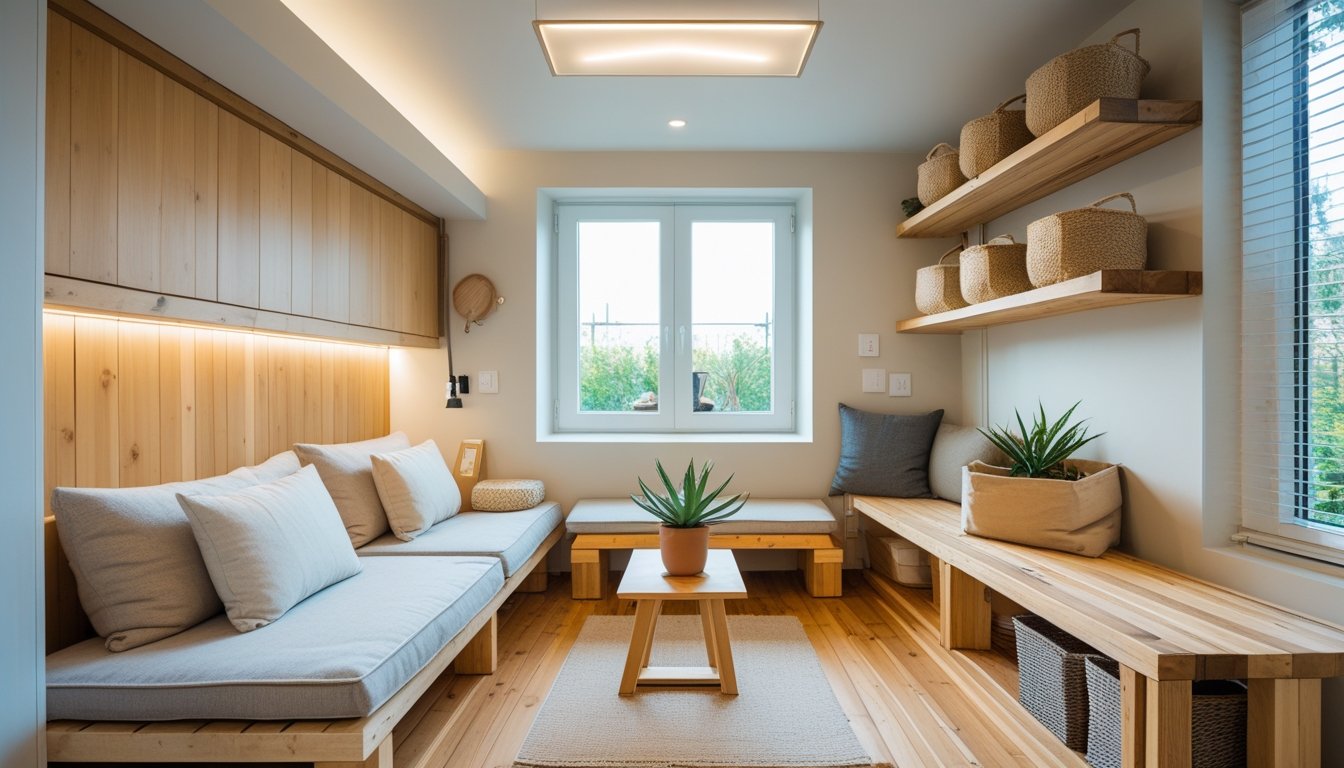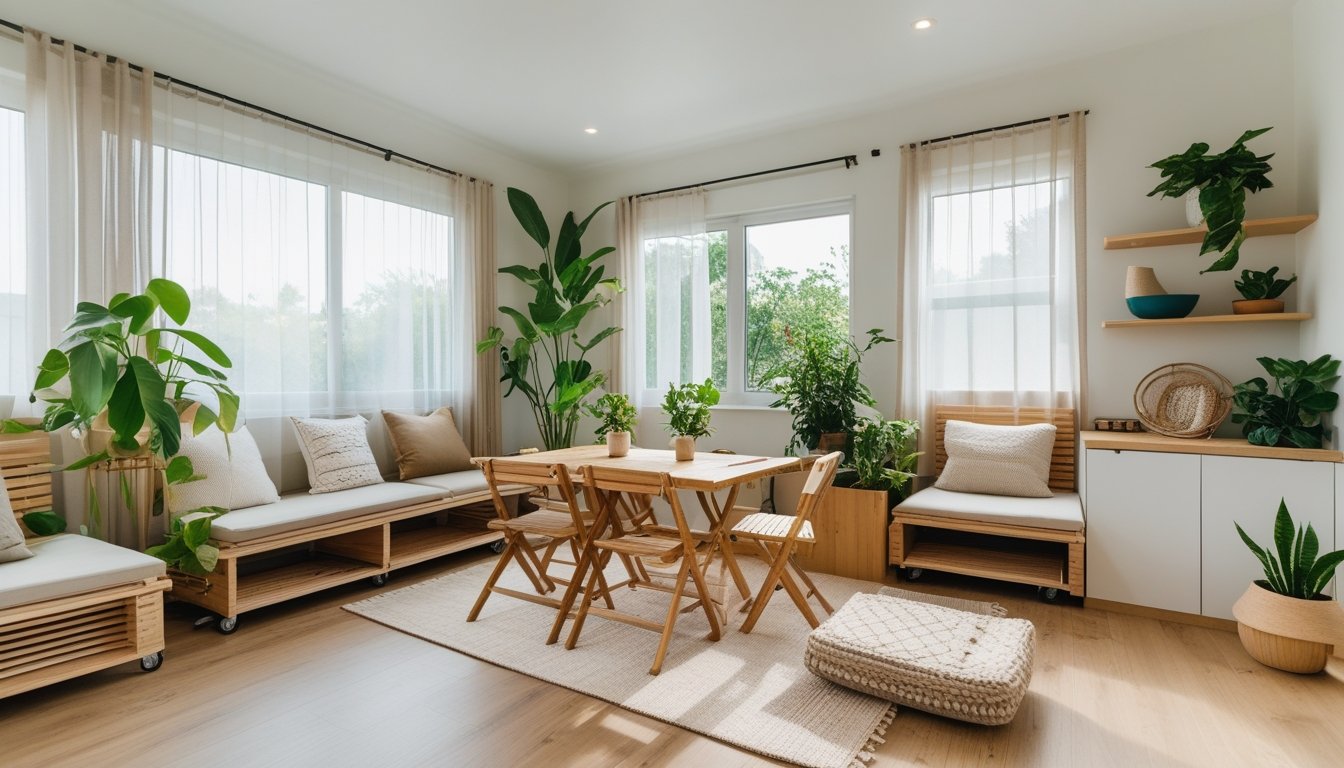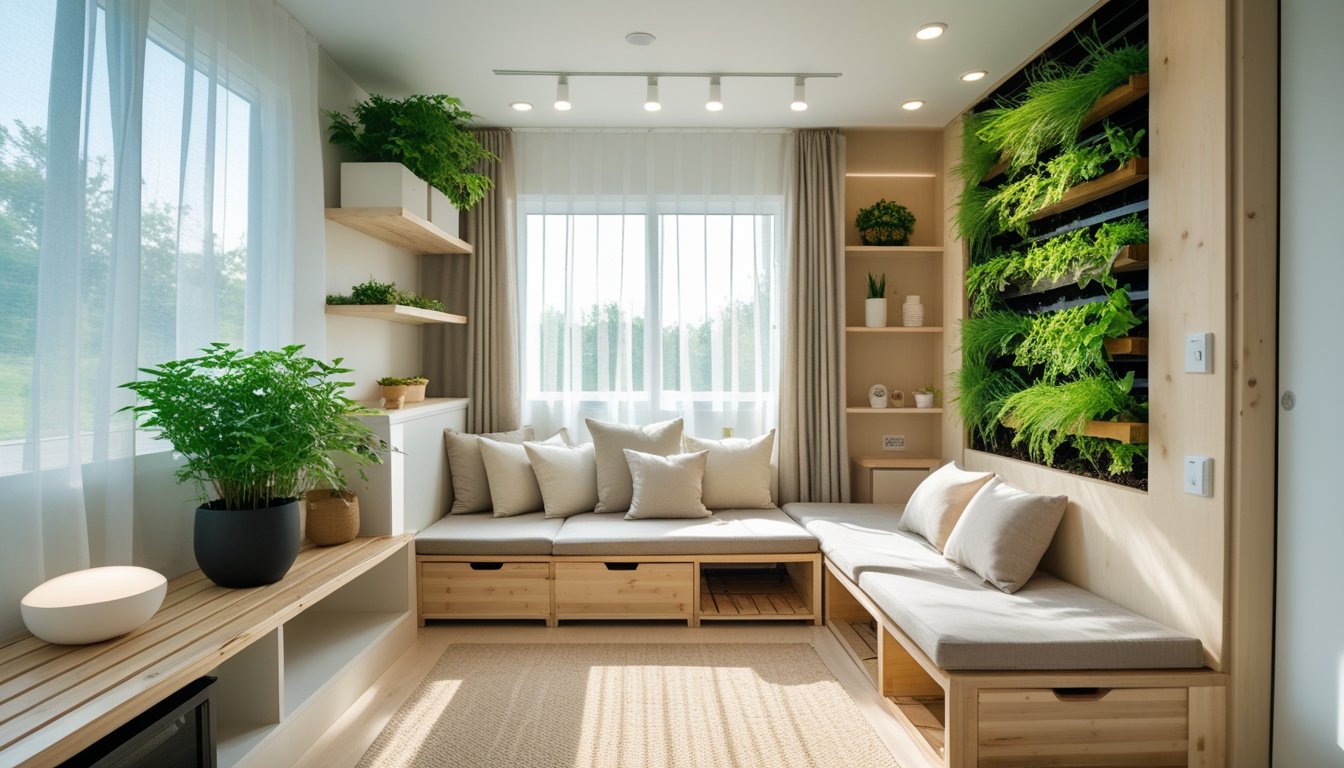Late updated: 03 Aug 2025 15:08
Written by: Daniel Harper
Sustainable Interior Design Tricks for Small Spaces: Enhance Comfort and Style
Sustainable interior design in small spaces offers a unique opportunity to create stylish, eco-friendly living areas without compromising on function or comfort. As we explore innovative design strategies, the focus remains on maximising efficiency while maintaining an aesthetic appeal. Whether through multi-functional furniture, clever storage solutions, or the use of eco-friendly materials, these techniques are designed not just to enhance the environment, but also to elevate your living experience.

Incorporating sustainability into compact interiors can seamlessly transform the way we use and perceive space. Simple changes, like integrating vertical gardens or opting for light colour palettes, can have a significant impact, both visually and environmentally. Sustainable design isn't just about the products we choose; it's an approach to thoughtful living that respects nature and fosters resourcefulness.
The beauty of sustainable design lies not only in aesthetics but in its ability to adapt to our needs. We can create spaces that reflect our lifestyle and values by implementing practical and eco-conscious strategies. Let's delve into these exciting possibilities and redefine how small spaces can be both sustainable and stylish.
Key Takeaways
- Sustainable styling maximises efficiency and aesthetics.
- Small changes can transform compact interiors.
- Eco-conscious living enhances lifestyle and values.
Sustainable Interior Design Fundamentals for Small Spaces

For small spaces, adopting sustainable interior design practices is crucial. We focus on selecting eco-friendly materials, maximising natural light, and incorporating elements that connect us with nature.
Selecting Eco-Friendly Materials and Finishes
Choosing sustainable materials is a key step. Bamboo and reclaimed wood are popular due to their renewability. They bring warmth and texture without compromising the environment. Low-VOC (Volatile Organic Compounds) paints, which have fewer harmful emissions, are ideal for ensuring healthier air quality indoors.
Additionally, recycled glass and tiles make excellent finishes that elevate aesthetics and support recycling efforts. Opting for these ensures minimal waste and supports eco-friendly production processes. Small spaces benefit from materials that are both functional and aligned with our environmental ethics.
Maximising Natural Light and Ventilation
Natural light can make a significant difference in small interiors, creating a sense of larger space. To achieve this, consider using light-coloured sheer curtains that allow the sun in while maintaining privacy. Mirrors and reflective surfaces can amplify this effect by distributing light evenly across the room.
Ventilation goes hand in hand with natural light. Cross-ventilation can be achieved by strategically placing windows or vents on opposite sides. This not only enhances indoor air quality but also reduces dependency on artificial cooling systems. Employing these strategies contributes significantly to a more sustainable living environment.
Incorporating Biophilic Elements
Biophilic design envelops bringing elements of nature into our interiors, nurturing a connection with the environment even in small spaces. Indoor plants, such as succulents or ferns, enhance air quality and offer visual beauty. Vertical gardens can be an innovative way to integrate greenery without sacrificing floor area.
Textures that mimic natural surfaces—like stone murals or wooden accents—create an organic feel. Incorporating these elements can foster well-being and make small spaces more inviting and tranquil. By embedding biophilic design principles, we uphold a sustainable ethos while enriching our indoor environment.
Practical Sustainable Tricks to Enhance Compact Interiors

In compact interiors, sustainable design is key to enhancing functionality and aesthetics. With smart space planning, effective use of colour, optimised storage, and creative decor, we can transform small spaces into eco-friendly havens.
Smart Space Planning and Multipurpose Furniture
In compact spaces, smart space planning is essential. Every square inch counts, so we should consider using multipurpose furniture to maximise functionality. Modular sofas can serve as seating, a bed, or even storage. Foldable tables are perfect for dining or as workspaces when needed. By incorporating furniture that adapts to our needs, we create flexible living areas.
We can also use vertical space to our advantage. Wall-mounted shelves and hooks make excellent storage solutions that keep the floor clear. This approach opens up the area, creating a sense of expansiveness. Let’s not forget about room dividers, like shelves, which can delineate spaces while offering extra storage. Tailoring our furniture to the dimensions of our small spaces turns potential constraints into assets.
Effective Use of Colour and Pattern
Colour and pattern wield tremendous power in transforming small spaces. Light colours, such as whites, creams, and pastels, reflect light, making rooms seem larger and more open. For those who prefer darker shades, using them sparingly as accents can create a sense of depth without overwhelming the space.
Patterns, when used strategically, can add personality and interest to a room. Vertical stripes can give the illusion of height, while geometric patterns on rugs can help define zones within an open-plan layout. Mirrors, another clever tool, reflect light and colour, amplifying the perceived volume of the room. Let's opt for eco-friendly paints and finishes to maintain sustainability while enhancing visual appeal.
Optimising Storage Solutions in Tight Areas
Storage, always a concern in small areas, requires creativity for optimisation. Use underutilised spaces like corners for storage. Corner shelves and units make excellent use of these areas, keeping essentials neatly organised.
Let's consider incorporating built-in storage solutions whenever possible. Built-in wardrobes, cabinets under stairs, or loft beds with drawers efficiently utilise vertical spaces without encroaching on the floor area. For items we regularly use, open shelving in kitchens or bathrooms keeps things accessible yet tidy. By addressing storage needs thoughtfully, we maintain an uncluttered, spacious feel.
Creative Green Decor Ideas
Decorating sustainably extends beyond furniture and storage. Greenery is a brilliant way to introduce nature into our environment. Small indoor plants or a vertical garden can purify the air and add vibrancy to the decor. Utilising recycled materials for decorative items is both environmentally friendly and trendy.
Let’s consider upcycling materials for a unique touch in our homes. Old glass jars can become stylish plant holders or candle containers. Using reclaimed wood for shelves or frames not only tells a story but also supports sustainable practices. When selecting decor pieces, focus on those that are both sustainably produced and capable of adding elegant touches to our compact spaces.
Frequently Asked Questions

In addressing sustainable interior design for compact spaces, we explore effective strategies for maximising space, cost-efficient methods, and using eco-friendly materials. Our focus also includes practical layout ideas and the integration of contemporary design with sustainable practices.
How can one maximise space in a single-occupancy small room using eco-friendly design?
To optimise space in a single-occupancy room, we recommend using multi-functional furniture, such as a bed with built-in storage. Mirrors can create the illusion of more space, whilst vertical shelves maximise wall use. Opting for natural or recycled materials maintains an eco-friendly approach.
What are cost-effective strategies for achieving a sustainable living room design in a small space?
Upcycling existing furniture is an excellent budget-friendly strategy. Repainting with eco-friendly paints and incorporating potted plants improve aesthetics and air quality. Additionally, selecting energy-efficient lighting and second-hand decor items contributes to sustainability without excess cost.
Could you list examples of sustainable materials suitable for interior design in compact homes?
Bamboo stands out as a rapidly renewable material. Reclaimed wood provides both sustainability and character. We also suggest using cork for flooring due to its renewability and durability. Natural fibres such as jute and wool are ideal for rugs and fabrics, enhancing the eco-friendly nature of the design.
What are efficient design layouts for a small two-bedroom house incorporating green principles?
In compact two-bedroom homes, open-plan designs allow for shared lighting, reducing energy use. Sliding doors can save space over traditional hinged models. Incorporating large windows can maximise natural light. We also recommend zoning spaces by activity, which helps maintain functionality while maintaining an eco-friendly ethos.
How can interior design in limited spaces be both modern and environmentally sustainable?
Opt for sleek, minimalistic furniture made from sustainable materials like reclaimed metal or glass. The use of neutral, natural colours complements a modern aesthetic while conserving resources. Smart technology can improve energy efficiency, offering a bridge between modern convenience and environmental responsibility.
What tips can you offer for creating multi-functional areas in a small home without compromising on sustainability?
Space-saving ideas such as fold-out desks or tables can turn a single room into a multipurpose area. Choose sustainably-made Murphy beds for added functionality. Implementing flexible furniture layouts allows for easy transformation between living, working, and recreational spaces without increased environmental impact.
